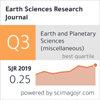江苏泥沙SPT-N与小应变剪切模量Gmax相关性表征
IF 0.5
4区 地球科学
Q4 GEOSCIENCES, MULTIDISCIPLINARY
引用次数: 0
摘要
小应变剪切模量在场地响应参数的评价中起着基础性的作用。只有少数作者使用测量密度和剪切波速(Vs)来估计小应变剪切模量。在本研究中,我们试图建立标准贯入试验(SPT) N值与小应变剪切模量(Gmax)之间的回归关系。为此,利用了中国苏新高速公路现场调查SPT和地震压电锥贯入试验(SCPTU)数据,这些数据也用于地面改善工程。利用未受扰动的钻孔土样估算了土层的原位密度。在靠近钻孔的位置获得了随深度的v剖面。小应变剪切模量通过实测v值和原位土密度计算得到。使用约50对SPT-N和Gmax值进行回归分析。分析了拟合回归关系中实测值与校正值之间的差异。现有的相关性大多基于日本和印度的研究,其中N值的锤能量为78%,由于SPT锤能量的变化在中国约为55%,因此可能不直接适用于其他地区。利用中国泥沙的测量值,产生了一种新的相关性。本研究发现,与修正后的N和修正后的模量值相比,未修正的N和模量值给出了最好的拟合回归关系。由于大多数方程用于砂土和粘土,修正后的N值与模量之间的回归关系给出了中国泥沙方程。本文章由计算机程序翻译,如有差异,请以英文原文为准。
Characterization on the correlation between SPT-N and small strain shear modulus Gmax of Jiangsu silts of China
Small strain shear modulus plays a fundamental role in the evaluation of site response parameters. Only few authors used measured density and shear wave velocity (Vs) to estimate small strain shear modulus. In this study, an attempt has been made to develop the regression relationship between standard penetration test (SPT) N values and the small strain shear modulus (Gmax). For this purpose, field investigations SPT and seismic piezocone penetration test (SCPTU) data from locations in Su-Xin Expressway of China, have been used, which were also used for ground improvement project. The in situ density of soil layer was estimated using undisturbed soil samples from the boreholes. The Vs profiles with depth were obtained for the locations close to the boreholes. The values for small strain shear modulus have been calculated by measured Vs and in situ soil density. About 50 pairs of SPT-N and Gmax values were used for regression analysis. The differences between measured and corrected values which were used in fitted regression relations were analyzed. Most of the existing correlations were developed based on the studies carried out in Japan and in India, where N values are measured with hammer energy of 78%, which may not be directly applicable for other regions because of the variation in SPT hammer energy which in China is about 55%. A new correlation has been generated using the measured values in silts of China. From this study, it is found that uncorrected values of N and modulus gives the best fit regression relations when compared to corrected N and corrected modulus values. With most equation was used for sand and clay, the regression relations between corrected values of N and modulus gives the equation of silts in China.
求助全文
通过发布文献求助,成功后即可免费获取论文全文。
去求助
来源期刊

Earth Sciences Research Journal
地学-地球科学综合
CiteScore
1.50
自引率
0.00%
发文量
0
审稿时长
>12 weeks
期刊介绍:
ESRJ publishes the results from technical and scientific research on various disciplines of Earth Sciences and its interactions with several engineering applications.
Works will only be considered if not previously published anywhere else. Manuscripts must contain information derived from scientific research projects or technical developments. The ideas expressed by publishing in ESRJ are the sole responsibility of the authors.
We gladly consider manuscripts in the following subject areas:
-Geophysics: Seismology, Seismic Prospecting, Gravimetric, Magnetic and Electrical methods.
-Geology: Volcanology, Tectonics, Neotectonics, Geomorphology, Geochemistry, Geothermal Energy, ---Glaciology, Ore Geology, Environmental Geology, Geological Hazards.
-Geodesy: Geodynamics, GPS measurements applied to geological and geophysical problems.
-Basic Sciences and Computer Science applied to Geology and Geophysics.
-Meteorology and Atmospheric Sciences.
-Oceanography.
-Planetary Sciences.
-Engineering: Earthquake Engineering and Seismology Engineering, Geological Engineering, Geotechnics.
 求助内容:
求助内容: 应助结果提醒方式:
应助结果提醒方式:


